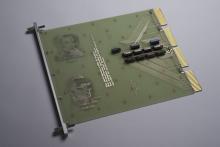
Homegrown networking technology pre-dating the internet.
This is a CERNnet card developed and built at CERN. There was a lot of space on the card between the components, so the engineers decided to put their portraits on it.
For an extensive history on the beginning of networking at CERN, see Ben Segal's notes.
Networking in the beginning was - chaos. In the same way that the theory of high energy physics interactions was itself in a chaotic state up until the early 1970's, so was the so-called area of "Data Communications" at CERN. The variety of different techniques, media and protocols used was staggering; open warfare existed between many manufacturers' proprietary systems, various home-made systems (including CERN's own "FOCUS" and "CERNET"), and the then rudimentary efforts at defining open or international standards. There were no general purpose Local Area Networks (LANs): each application used its own approach. The only really widespread CERN network at that time was "INDEX": a serial twisted pair system with a central Gandalf circuit switch, connecting some hundreds of "dumb" terminals via RS232 to a selection of accessible computer ports for interactive login.
CERNET, beginning in 1976, offered a fast file transfer service between a number of mainframes and minicomputers via 2Mbit/s serial lines using packet switching in a network of gateway nodes. Remote login (known as "virtual terminal service") was only supported to a single system, the central IBM mainframe. At the end of its ten year life (~1988) CERNET supported 100 systems, including its own version of a LAN bridge, connecting some of CERN's first Ethernets. However, even though architecturally CERNET resembled ARPAnet, all its protocols had been developed independently. It was therefore doomed, though this was of course unknown at the beginning. Even if its designers had been in contact with Vint Cerf and company, there was no efficient way to run a transatlantic collaboration. Imagine a period without electronic mail... but no, this was only introduced at CERN to any extent at the beginning of the 1980's.
